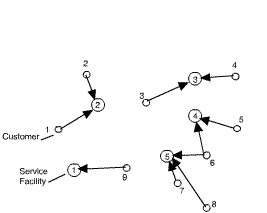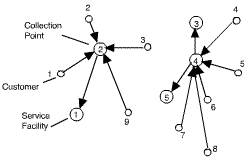A company has n customers located throughout a geographic
area. Customer i has a demand d(i) for some service.
The company has m service facilities. Service facility
j has capacity b(j). The cost c(i, j) is
the roundtirp cost of shipping a single unit of demand from customer
i to facility j.
a. Show the network model that will find an optimum
assignment of customers to service facilities. The goal is to
minimize total shipping cost. Assume the total service capacity
is greater than the total demand.
The figure below shows a schematic of the situation with one
possible assignment of customers to service facilities. Note
that it is possible to share the load from a particular customer
as is illustrated for customer 6.

b. Add to the situation of the problem a cost of processing
at the service stations. The unit cost of processing demand
up to the amount m(j)/3 is p(j). The unit processing
cost for amounts between m(j)/3 and 2m(j)/3 is
1.2 p(j). For any amount between 2m(j)/3
and m(j) the processing cost is 1.5p(j). m(j)
and p(j)are parameters given for each service facility.
Now the goal is to minimize shipping plus processing costs.
Show the change in the model necessary to accommodate this.
c. Consider the original problem situation (do not include
the change in problem b). There is quite a bit of excess capacity
in the system, so the company is changing a specified set of
service facilities into collection points. Customers will ship
to a collection point. The collection point will combine orders
and then ship them to the service facilities. The return trip
follows the same rout in reverse. Since shipments from collection
points to service facilities will be in large volumes, total
shipping cost may be reduced by this strategy.
Let e(i, j) be the roundtrip unit shipping cost from
a collection point i to service facility j. When
a service facility is a collection point it no longer will be
able to to satisfy demand. If service facility j becomes
a collection point its collection capacity is f(j).
The figure shows a possible solution to the new situation in
which facilities 2 and 4 have been turned into collection points.
Facilities 1, 3 and 5 perform the service.

Show a network model to solve the new problem.
|



